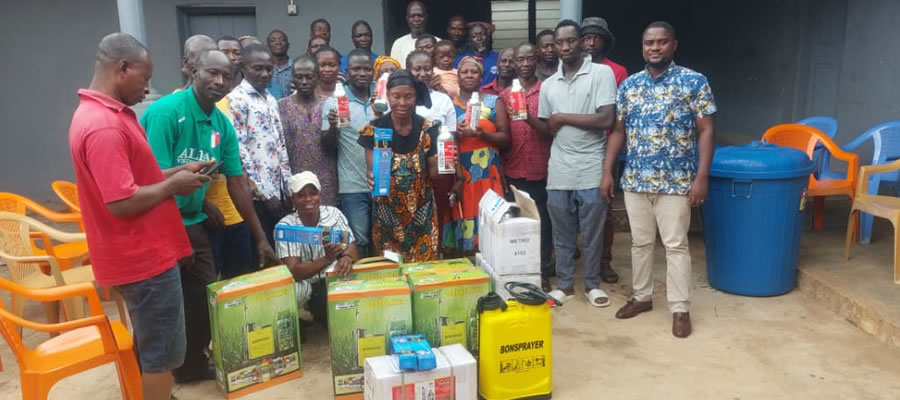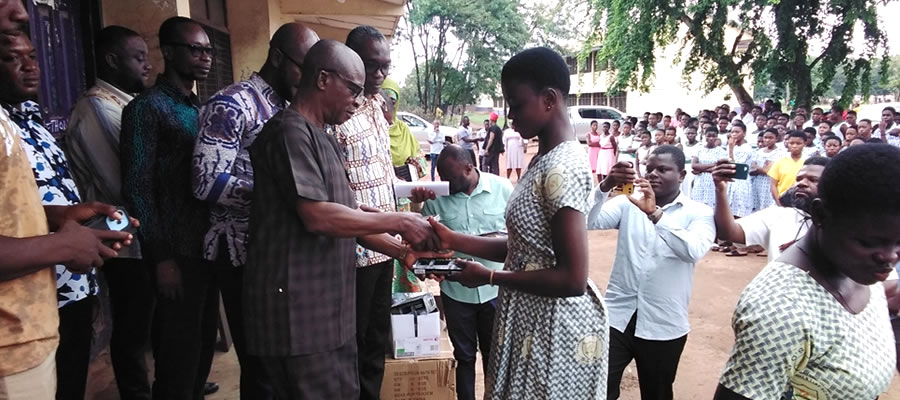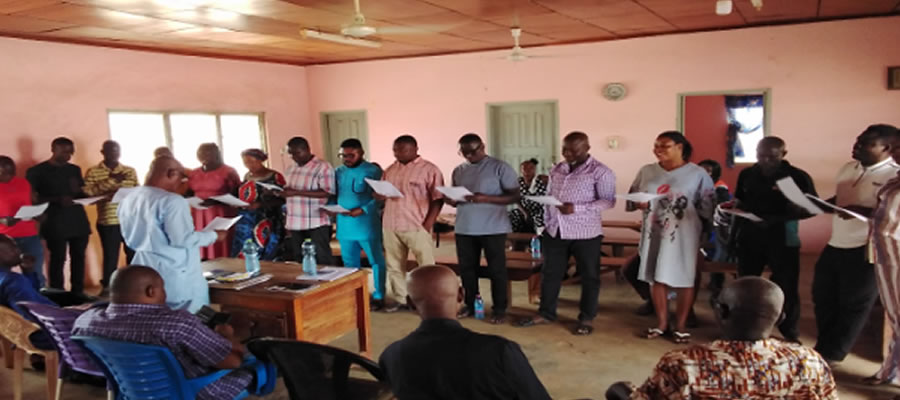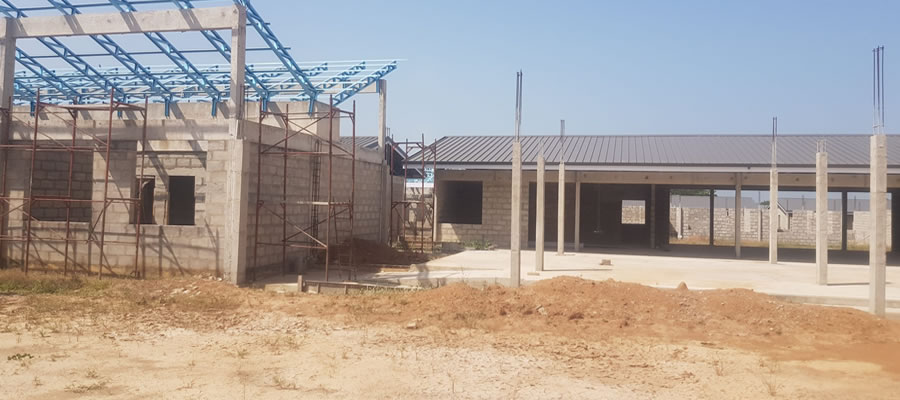

A District’s population size and age-sex component have broad consequences on a number of socio-economic indicators such as, the welfare of the people. An understanding of the age and sex structure of a population yields insight into changing population structure and highlights social and economic challenges. All levels of government need information on age and sex composition of the population for planning and development and in provision of services. This Chapter therefore provides information on the age and sex structure of the population of the Sunyani West Municipality, locality of residence, dependency ratios, and fertility, mortality and migration patterns.
Population size and distribution
Table 2.1 shows the distribution of the Municipality’s population by age, sex and locality of residence. The Sunyani West Municipality has a total population of 85,272, which constitutes 3.7 percent of the Bono Region’s population. There are more females (43,884) than males (41, 388) in the Municipality. The sex ratio is 94.3 (i.e., about 94 males to 100 females), which means that females are about six percent more than males.
Age and sex structure
The age structure of the population is characterized by a broad base and a narrow peak towards the older ages for both sexes. The population structure for the Municipality is similar to both the Regional and National structures.
The dependency ratio determines the relative size of the population of dependent ages (persons below 15 years and persons 65 years and older) to those in the productive ages (person 15 – 64 years). The total dependency ratio for the Municipality is 74.9, which means that for every 100 persons in the working-age- population there are about 75 persons in the dependent group to support. The dependency ratio for the Municipality is however lower than the Regional average of 81.3. In rural-urban dichotomy, the rural dependency ratio (82.7) is higher than the urban ratio of 71.8.
Fertility, Mortality and Migration
Fertility
Fertility refers to the frequency of child bearing among a population. Fertility rate measures the relative frequency with which births occur within a given population and is measured by; Total Fertility Rate (TFR), General Fertility Rate (GFR), and Crude Birth Rate (CBR). The Total Fertility Rate (TFR) which is the average number of live births per 1,000 women 15-49 years exposed throughout their child bearing years given that the prevailing age specific rates remain. General Fertility Rate (GFR) is the number of births in a given year divided by the mid- year population of women in the age group15-49. Crude Birth Rate (CBR) on the other hand is the total number of births in the population. Fertility is influenced not only by age but also by factors such as marriage, place of residence and educational attainment.
Table 2.3 presents information on reported total fertility rate, general fertility rate and crude birth rate for the Municipality and the Region. Sunyani West Municipal has a TFR of 3.2 which means that every woman in the reproductive age have averagely three children. GFR is almost 96 (95.8) live births per 1000 women whereas the CBR is almost 25 (25.2) live births per 1000 populations. The relatively low fertility in the Municipality could be explained by factors such as the urbanized nature of the Municipality (fourth urbanized in the region).
Children ever born and surviving
The number of children ever born per woman measures the life time and cumulative fertility performance of females in the reproductive age group 15-49 years. About 75,742 children have ever been born and 65,701 are surviving by females aged 12 years and older in the District. Table 2.4 shows that the number of children ever born increases with age and gets to highest point at age 39. Children surviving include all children (male and female) born alive by females 12 years and older who are still living. Females aged (12-14) years old have zero births. Discounting females aged 60 years and older, females aged 35-39 have highest proportion for both sexes (12.6%) with Children Ever Born (CEB) 12 percent (male 12.6% and female 12.1%). Also for children surviving the highest proportion for both sexes are (13.1%) while male (13.4%) and female (12.7%). They are followed closely by those aged 30-34 and 40-44 years.
Mortality
Mortality, as one of the three components of population change, plays an important role that determines the growth of a population. Mortality is the occurrence of deaths in a population. The level and pattern of mortality is a reflection of the health status of a population. A total of 462 deaths were recorded in the 12 months preceding the Census Night, yielding CDR of a little more than five deaths in every 1000 population. This shows that the mortality experience in the Municipality is lower than that of the Region generally.
Table 2.5 shows the total population, deaths in households and crude death rates for the Municipality and the Region. Crude Death Rate (CDR), the number of deaths in a year per 1000 mid-year population of a specific year. Out of the total population of 85,272, the total number of deaths in households is 462, which translates into a crude death rate of 5.4 per 1000. This means about five deaths occurred among 1000 persons in the 12 months preceding the Census Night. The CDR for the Municipality is less than the Regional CDR of 6.1.
Causes of deaths
Table 2.6 presents the causes of death by Municipality. Out of a total of 462 deaths recorded in the Municipality, 15.2 percent are due to accident/violence/homicide/suicide whiles 84.8 percent are due to other causes such as natural deaths. The Municipality’s percentage of deaths caused by accident is almost twice that of the region (8.7%).
Age specific death rates
Figure 2.2 shows reported age specific death rates by sex. The rate is high at birth for the population below five years with female deaths slightly higher than the males. The male mortality rate accounts for lowest in the age 15-19 while female mortality rate remains high through to age 39. From age 60 the male mortality rate picks up momentum and increases at a faster rate whereas that of the female picks up momentum at age 65; that is after five years.
Population Size and Growth Rate
The population of the Municipality has been growing steadily since 1970 with the population of the Municipality as a percentage of the regional population also increasing from 3.8% in 1970 to 4.4% in 2000. The 2000 population and housing census put the population of the Municipality at 79,241 with a growth rate of 3.0%. This is depicted in table 2.1 below.
The increase in the Municipality’s population may be attributed to in-migration to Odomase Berlin Top, Nsoatre, and Chiraa because of their nearness to the Regional capital (Sunyani). And the influx settler farmers into major farming areas like Adentia, Abronye, Kobedi and Dumasua
Population Density
The distribution of population in the Municipality is generally skewed. The Four Largest localities (Nsoatre, Chiraa, Odomase, and Fiapre) hold about 40.76% of the Municipality’s population with 59.24% distributed among the other settlements. The concentration of population in the four major settlements has increased demand for utility services such as water and electricity, with social services such as education and health facilities also in high demand. Equally there is pressure on accommodation. Waste generation has also increased. Population density for the Municipality increased from 26 PP/km2 in 1984 to 48 PP/km2 in 2000 marking an increase of 54.1% (Table 2.2 below).
Sex Composition
The 2000 population and housing census indicates that the Municipality’s population comprises 38,982 males (49.2%) and 40,259 females (50.8%) as compared to the regional figures of 50.03% males and 49.97% females.
Household Size/Characteristics
The 2000 population and housing census indicate that the Average household size for the Municipality is 5.7. This is a little over the Regional Average Household size of 5.3 and the National average of 5.1. Household sizes ranges between 1-3 and 4-6 members and above 7 members. On the whole, household in the urban areas of the Municipality are quite larger than those in the rural areas. Females head more than a third (34.6%) of the household in the Municipality.
Date Created : 4/11/2022 12:00:00 AM













 facebook
facebook
 twitter
twitter
 Youtube
Youtube
 +233 593 831 280
+233 593 831 280 0800 430 430
0800 430 430 GPS: GE-231-4383
GPS: GE-231-4383 info@ghanadistricts.com
info@ghanadistricts.com Box GP1044, Accra, Ghana
Box GP1044, Accra, Ghana